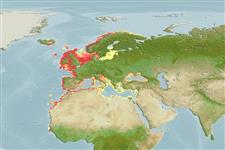Classification / Names
Common names from other countries
Main reference
Size / Weight / Age
Max length : 103 cm TL male/unsexed; (Ref. 40637); common length : 50.0 cm TL male/unsexed; (Ref. 6916); max. published weight: 12.0 kg (Ref. 1468); max. reported age: 30 years (Ref. 59043)
Length at first maturity
Lm 32.3, range 23 - 46 cm
Environment
Marine; freshwater; brackish; demersal; oceanodromous; depth range 10 - 100 m (Ref. 9987)
Climate / Range
Subtropical; 8°C - 24°C (Ref. 4944), preferred 11°C (Ref. 107945); 72°N - 11°N, 19°W - 42°E (Ref. 54221)
Distribution
Short description
Dorsal
spines
(total): 8 - 10;
Dorsal
soft rays
(total): 12-13;
Anal
spines: 3;
Anal
soft rays: 10 - 12. Diagnosis: head with cycloid scales above; mouth moderately protractile (Ref. 231). Vomerine teeth only anteriorly (Ref. 231), in a crescentic band (Ref. 231, 57391). Scales on interorbital space cycloid (Ref. 57391). Posterior edge of opercle finely serrated, lower edge with strong forward- directed denticles (Ref. 231). 2 flat opercular spines (Ref. 231, 57391). Young with some dark spots on upper part of body (Ref. 231).
IUCN Red List Status (Ref. 115185)
Threat to humans
Harmless
Human uses
Fisheries: commercial; aquaculture: commercial; gamefish: yes
Tools
Special reports
Download XML
Internet sources
Estimates of some properties based on models
Phylogenetic diversity index
PD50 = 0.7656 many relatives (e.g. carps) 0.5 - 2.0 few relatives (e.g. lungfishes)
Trophic Level
3.5 ±0.50 se; Based on food items.
Resilience
Medium, minimum population doubling time 1.4 - 4.4 years (K=0.06-0.33; tm=2-8; tmax=30; Fec=230,000)
Vulnerability
Moderate to high vulnerability (49 of 100)
Price category
